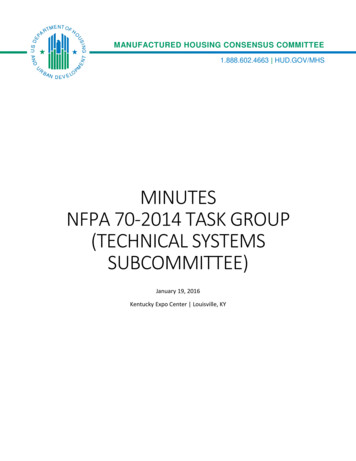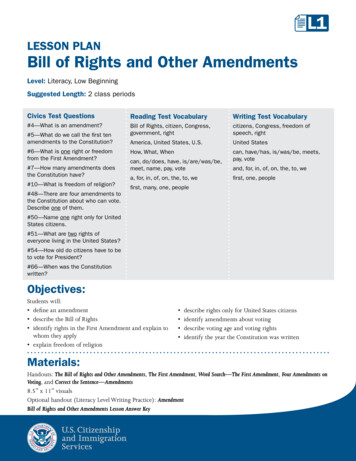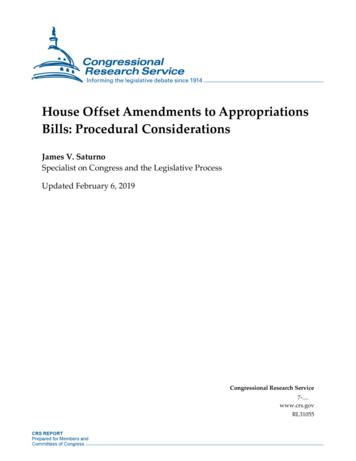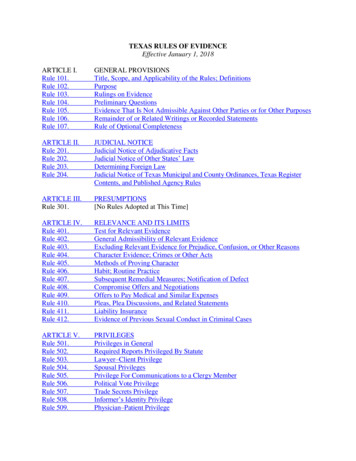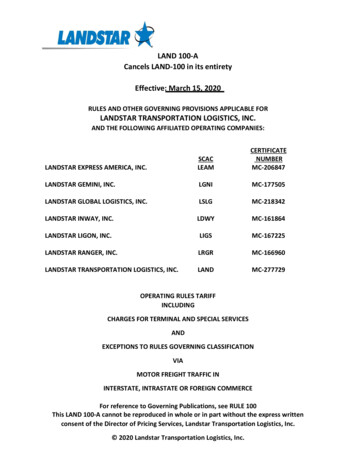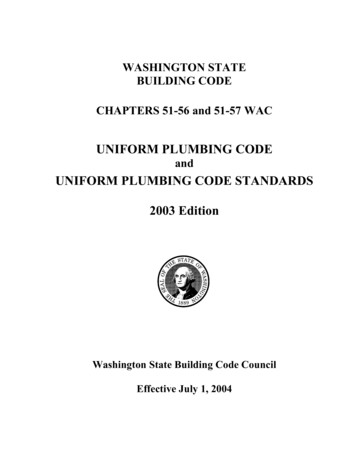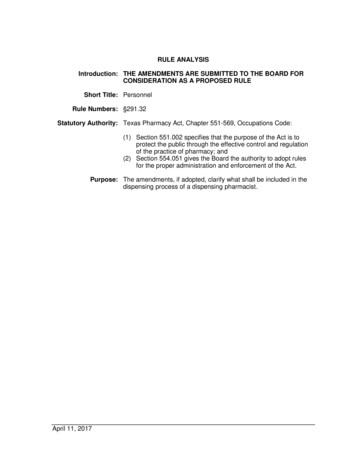
Transcription
RULE ANALYSISIntroduction: THE AMENDMENTS ARE SUBMITTED TO THE BOARD FORCONSIDERATION AS A PROPOSED RULEShort Title: PersonnelRule Numbers: §291.32Statutory Authority: Texas Pharmacy Act, Chapter 551-569, Occupations Code:(1) Section 551.002 specifies that the purpose of the Act is toprotect the public through the effective control and regulationof the practice of pharmacy; and(2) Section 554.051 gives the Board the authority to adopt rulesfor the proper administration and enforcement of the Act.Purpose: The amendments, if adopted, clarify what shall be included in thedispensing process of a dispensing pharmacist.April 11, 2017
03132333435363738394041424344454647484950TITLE 22EXAMINING BOARDSPART 15TEXAS STATE BOARD OF PHARMACYCHAPTER 291PHARMACIESSUBCHAPTER BCOMMUNITY PHARMACY (CLASS A)§291.32Personnel(a) Pharmacist-in-charge.(1) General.(A) Each Class A pharmacy shall have one pharmacist-in-charge who is employed on a fulltime basis, who may be the pharmacist-in-charge for only one such pharmacy; provided,however, such pharmacist-in-charge may be the pharmacist-in-charge of:(i) more than one Class A pharmacy, if the additional Class A pharmacies are not open toprovide pharmacy services simultaneously; or(ii) during an emergency, up to two Class A pharmacies open simultaneously if thepharmacist-in-charge works at least 10 hours per week in each pharmacy for no more than aperiod of 30 consecutive days.(B) The pharmacist-in-charge shall comply with the provisions of §291.17 of this title (relatingto Inventory Requirements).(C) The pharmacist-in-charge of a Class A pharmacy may not serve as the pharmacist-incharge of a Class B pharmacy or a Class C pharmacy with 101 beds or more.(2) Responsibilities. The pharmacist-in-charge shall have responsibility for the practice ofpharmacy at the pharmacy for which he or she is the pharmacist-in-charge. The pharmacist-incharge may advise the owner on administrative or operational concerns. The pharmacist-incharge shall have responsibility for, at a minimum, the following:(A) educating and training of pharmacy technicians and pharmacy technician trainees;(B) supervising a system to assure appropriate procurement of prescription drugs anddevices and other products dispensed from the Class A pharmacy;(C) disposing of and distributing drugs from the Class A pharmacy;(D) storing all materials, including drugs, chemicals, and biologicals;(E) maintaining records of all transactions of the Class A pharmacy necessary to maintainaccurate control over and accountability for all pharmaceutical materials required by applicablestate and federal laws and sections;(F) supervising a system to assure maintenance of effective controls against the theft ordiversion of prescription drugs, and records for such drugs;April 11, 20171
0(G) adhering to policies and procedures regarding the maintenance of records in a dataprocessing system such that the data processing system is in compliance with Class A(community) pharmacy requirements;(H) legally operating the pharmacy, including meeting all inspection and other requirements ofall state and federal laws or sections governing the practice of pharmacy; and(I) if the pharmacy uses an automated pharmacy dispensing system, shall be responsible forthe following:(i) consulting with the owner concerning and adherence to the policies and procedures forsystem operation, safety, security, accuracy and access, patient confidentiality, prevention ofunauthorized access, and malfunction;(ii) inspecting medications in the automated pharmacy dispensing system, at least monthly,for expiration date, misbranding, physical integrity, security, and accountability;(iii) assigning, discontinuing, or changing personnel access to the automated pharmacydispensing system;(iv) ensuring that pharmacy technicians, pharmacy technician trainees, and licensedhealthcare professionals performing any services in connection with an automated pharmacydispensing system have been properly trained on the use of the system and can demonstratecomprehensive knowledge of the written policies and procedures for operation of the system;and(v) ensuring that the automated pharmacy dispensing system is stocked accurately and anaccountability record is maintained in accordance with the written policies and procedures ofoperation.(b) Owner. The owner of a Class A pharmacy shall have responsibility for all administrative andoperational functions of the pharmacy. The pharmacist-in-charge may advise the owner onadministrative and operational concerns. The owner shall have responsibility for, at a minimum,the following, and if the owner is not a Texas licensed pharmacist, the owner shall consult withthe pharmacist-in-charge or another Texas licensed pharmacist:(1) establishing policies for procurement of prescription drugs and devices and other productsdispensed from the Class A pharmacy;(2) establishing policies and procedures for the security of the prescription departmentincluding the maintenance of effective controls against the theft or diversion of prescriptiondrugs;(3) if the pharmacy uses an automated pharmacy dispensing system, reviewing and approvingall policies and procedures for system operation, safety, security, accuracy and access, patientconfidentiality, prevention of unauthorized access, and malfunction;(4) providing the pharmacy with the necessary equipment and resources commensurate withits level and type of practice; andApril 11, 20172
151(5) establishing policies and procedures regarding maintenance, storage, and retrieval ofrecords in a data processing system such that the system is in compliance with state andfederal requirements.(c) Pharmacists.(1) General.(A) The pharmacist-in-charge shall be assisted by sufficient number of additional licensedpharmacists as may be required to operate the Class A pharmacy competently, safely, andadequately to meet the needs of the patients of the pharmacy.(B) All pharmacists shall assist the pharmacist-in-charge in meeting his or her responsibilitiesin ordering, dispensing, and accounting for prescription drugs.(C) Pharmacists are solely responsible for the direct supervision of pharmacy technicians andpharmacy technician trainees and for designating and delegating duties, other than those listedin paragraph (2) of this subsection, to pharmacy technicians and pharmacy technician trainees.Each pharmacist shall be responsible for any delegated act performed by pharmacy techniciansand pharmacy technician trainees under his or her supervision.(D) Pharmacists shall directly supervise pharmacy technicians and pharmacy techniciantrainees who are entering prescription data into the pharmacy's data processing system by oneof the following methods.(i) Physically present supervision. A pharmacist shall be physically present to directlysupervise a pharmacy technician or pharmacy technician trainee who is entering prescriptiondata into the data processing system. Each prescription entered into the data processingsystem shall be verified at the time of data entry. If the pharmacist is not physically present dueto a temporary absence as specified in §291.33(b)(3) of this title (relating to OperationalStandards), on return the pharmacist must:(I) conduct a drug regimen review for the prescriptions data entered during this time periodas specified in §291.33(c)(2) of this title; and(II) verify that prescription data entered during this time period was entered accurately.(ii) Electronic supervision. A pharmacist may electronically supervise a pharmacy technicianor pharmacy technician trainee who is entering prescription data into the data processingsystem provided the pharmacist:(I) is on-site, in the pharmacy where the technician/trainee is located;(II) has immediate access to any original document containing prescription information orother information related to the dispensing of the prescription. Such access may be throughimaging technology provided the pharmacist has the ability to review the original, hardcopydocuments if needed for clarification; and(III) verifies the accuracy of the data entered information prior to the release of theinformation to the system for storage and/or generation of the prescription label.April 11, 20173
202(iii) Electronic verification of data entry by pharmacy technicians or pharmacy techniciantrainees. A pharmacist may electronically verify the data entry of prescription information into adata processing system provided:(I) a pharmacist is on-site in the pharmacy where the pharmacy technicians/trainees arelocated;(II) the pharmacist electronically conducting the verification is either a:(-a-) Texas licensed pharmacist; or(-b-) pharmacist employed by a Class E pharmacy that:(-1-) has the same owner as the Class A pharmacy where the pharmacytechnicians/trainees are located; or(-2-) has entered into a written contract or agreement with the Class A pharmacy, whichoutlines the services to be provided and the responsibilities and accountabilities of eachpharmacy in compliance with federal and state laws and regulations;(III) the pharmacy establishes controls to protect the privacy and security of confidentialrecords; and(IV) the pharmacy keeps permanent records of prescriptions electronically verified for aperiod of two years.(E) All pharmacists, while on duty, shall be responsible for the legal operation of thepharmacy and for complying with all state and federal laws or rules governing the practice ofpharmacy.(F) A dispensing pharmacist shall be responsible for and ensure that the drug is dispensedand delivered safely, and accurately as prescribed, unless the pharmacy's data processingsystem can record the identity of each pharmacist involved in a specific portion of thedispensing processing. If the system can track the identity of each pharmacist involved in thedispensing process, each pharmacist involved in the dispensing process shall be responsible forand ensure that the portion of the process the pharmacist is performing results in the safe andaccurate dispensing and delivery of the drug as prescribed. The dispensing process shallinclude, but not be limited to, drug regimen review and verification of accurate prescription dataentry, including [data entry of] prescriptions placed on hold, packaging, preparation,compounding, transferring, labeling, and performance of the final check of the dispensedprescription. An intern has the same responsibilities described in this subparagraph as apharmacist but must perform his or her duties under the supervision of a pharmacist.(2) Duties. Duties which may only be performed by a pharmacist are as follows:(A) receiving oral prescription drug orders and reducing these orders to writing, eithermanually or electronically;(B) interpreting prescription drug orders;(C) selecting drug products;April 11, 20174
253(D) performing the final check of the dispensed prescription before delivery to the patient toensure that the prescription has been dispensed accurately as prescribed;(E) communicating to the patient or patient's agent information about the prescription drug ordevice which in the exercise of the pharmacist's professional judgment, the pharmacist deemssignificant, as specified in §291.33(c) of this title;(F) communicating to the patient or the patient's agent on his or her request informationconcerning any prescription drugs dispensed to the patient by the pharmacy;(G) assuring that a reasonable effort is made to obtain, record, and maintain patientmedication records;(H) interpreting patient medication records and performing drug regimen reviews;(I) performing a specific act of drug therapy management for a patient delegated to apharmacist by a written protocol from a physician licensed in this state in compliance with theMedical Practice Act;(J) verifying that controlled substances listed on invoices are received by clearly recordinghis/her initials and date of receipt of the controlled substances; and(K) transferring or receiving a transfer of original prescription information on behalf of apatient.(3) Special requirements for compounding. All pharmacists engaged in compounding nonsterile preparations shall meet the training requirements specified in §291.131 of this title(relating to Pharmacies Compounding Non-Sterile Preparations).(d) Pharmacy Technicians and Pharmacy Technician Trainees.(1) General.(A) All pharmacy technicians and pharmacy technician trainees shall meet the trainingrequirements specified in §297.6 of this title (relating to Pharmacy Technician and PharmacyTechnician Trainee Training).(B) Special requirements for compounding. All pharmacy technicians and pharmacytechnician trainees engaged in compounding non-sterile preparations shall meet the trainingrequirements specified in §291.131 of this title.(2) Duties.(A) Pharmacy technicians and pharmacy technician trainees may not perform any of theduties listed in subsection (c)(2) of this section.(B) A pharmacist may delegate to pharmacy technicians and pharmacy technician traineesany nonjudgmental technical duty associated with the preparation and distribution ofprescription drugs provided:April 11, 20175
304(i) a pharmacist verifies the accuracy of all acts, tasks, and functions performed bypharmacy technicians and pharmacy technician trainees;(ii) pharmacy technicians and pharmacy technician trainees are under the direct supervisionof and responsible to a pharmacist; and(iii) only pharmacy technicians and pharmacy technician trainees who have been properlytrained on the use of an automated pharmacy dispensing system and can demonstratecomprehensive knowledge of the written policies and procedures for the operation of the systemmay be allowed access to the system.(C) Pharmacy technicians and pharmacy technician trainees may perform onlynonjudgmental technical duties associated with the preparation and distribution of prescriptiondrugs, as follows:(i) initiating and receiving refill authorization requests;(ii) entering prescription data into a data processing system;(iii) taking a stock bottle from the shelf for a prescription;(iv) preparing and packaging prescription drug orders (i.e., counting tablets/capsules,measuring liquids and placing them in the prescription container);(v) affixing prescription labels and auxiliary labels to the prescription container;(vi) reconstituting medications;(vii) prepackaging and labeling prepackaged drugs;(viii) loading bulk unlabeled drugs into an automated dispensing system provided apharmacist verifies that the system is properly loaded prior to use;(ix) compounding non-sterile prescription drug orders; and(x) compounding bulk non-sterile preparations.(3) Ratio of on-site pharmacist to pharmacy technicians and pharmacy technician trainees.(A) Except as provided in subparagraph (B) of this paragraph, the ratio of on-site pharmaciststo pharmacy technicians and pharmacy technician trainees may be 1:4, provided the pharmacistis on-site and at least one of the four is a pharmacy technician. The ratio of pharmacists topharmacy technician trainees may not exceed 1:3.(B) As specified in §568.006 of the Act, a Class A pharmacy may have a ratio of on-sitepharmacists to pharmacy technicians/pharmacy technician trainees of 1:5 provided:(i) the Class A pharmacy:(I) dispenses no more than 20 different prescription drugs; andApril 11, 20176
1322323324325326327328329330331332333334335(II) does not produce sterile preparations including intravenous or intramuscular drugs onsite; and(ii) the following conditions are met:(I) at least four are pharmacy technicians and not pharmacy technician trainees; and(II) The pharmacy has written policies and procedures regarding the supervision ofpharmacy technicians and pharmacy technician trainees, including requirements that thepharmacy technicians and pharmacy technician trainees included in a 1:5 ratio may be involvedonly in one process at a time. For example, a technician/trainee who is compounding non-sterilepreparations or who is involved in the preparation of prescription drug orders may not also callphysicians for authorization of refills.(e) Identification of pharmacy personnel. All pharmacy personnel shall be identified as follows.(1) Pharmacy technicians. All pharmacy technicians shall wear an identification tag or badgethat bears the person's name and identifies him or her as a pharmacy technician, or a certifiedpharmacy technician, if the technician maintains current certification with the PharmacyTechnician Certification Board or any other entity providing an examination approved by theboard.(2) Pharmacy technician trainees. All pharmacy technician trainees shall wear an identificationtag or badge that bears the person's name and identifies him or her as a pharmacy techniciantrainee.(3) Pharmacist interns. All pharmacist interns shall wear an identification tag or badge thatbears the person's name and identifies him or her as a pharmacist intern.(4) Pharmacists. All pharmacists shall wear an identification tag or badge that bears theperson's name and identifies him or her as a pharmacist.April 11, 20177
156 (I) a pharmacist is on-site in the pharmacy where the pharmacy technicians/trainees are 157 located; 158 159 (II) the pharmacist electronically conducting the verification is either a: 160 161 (-a-) Texas licensed pharmacist; or 162 163 (-b-) pharmacist employed by a Class E pharmacy that: 164


